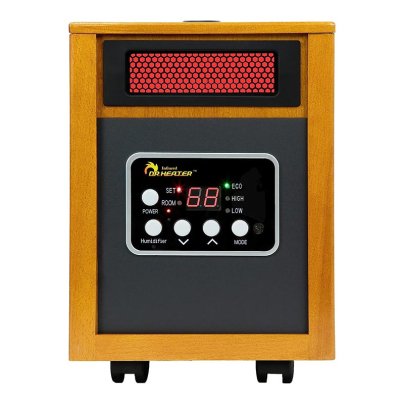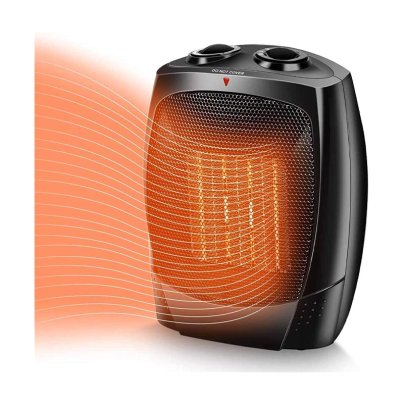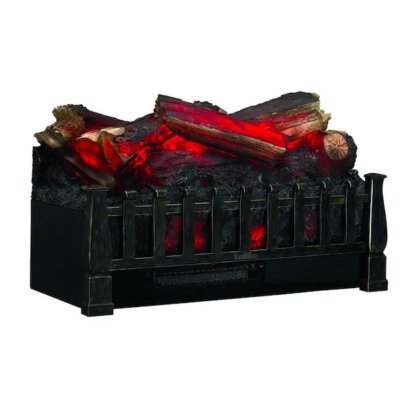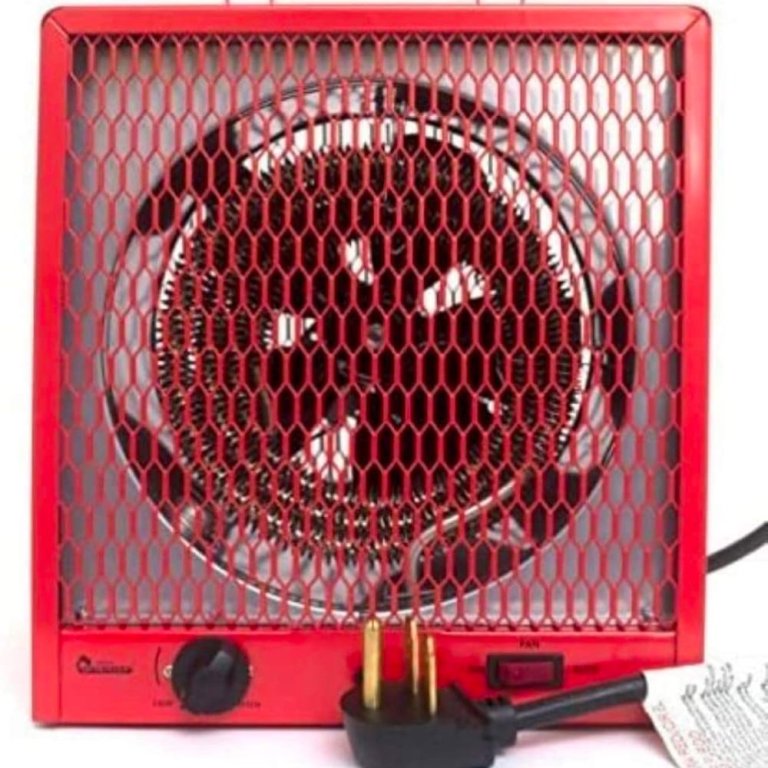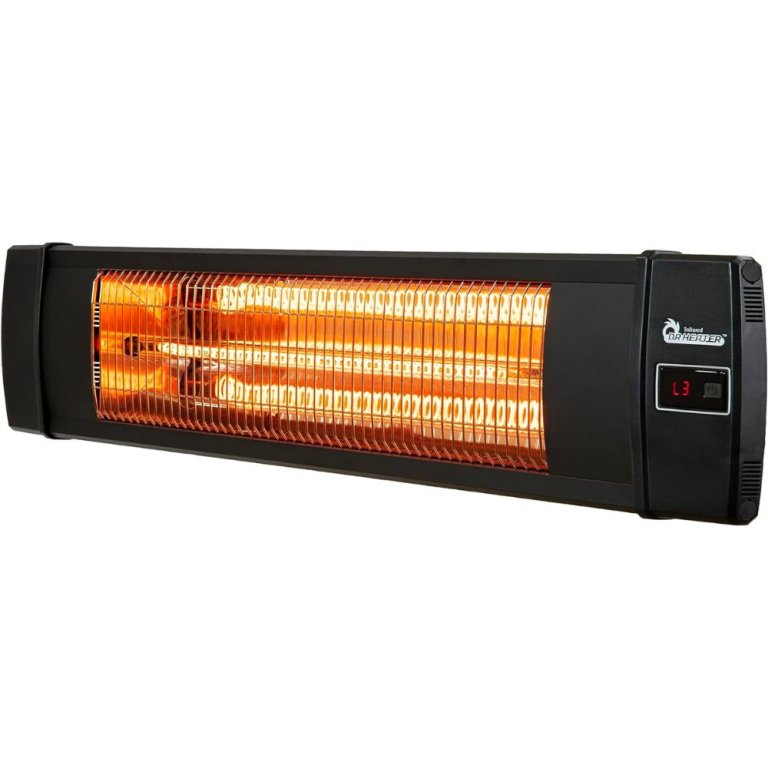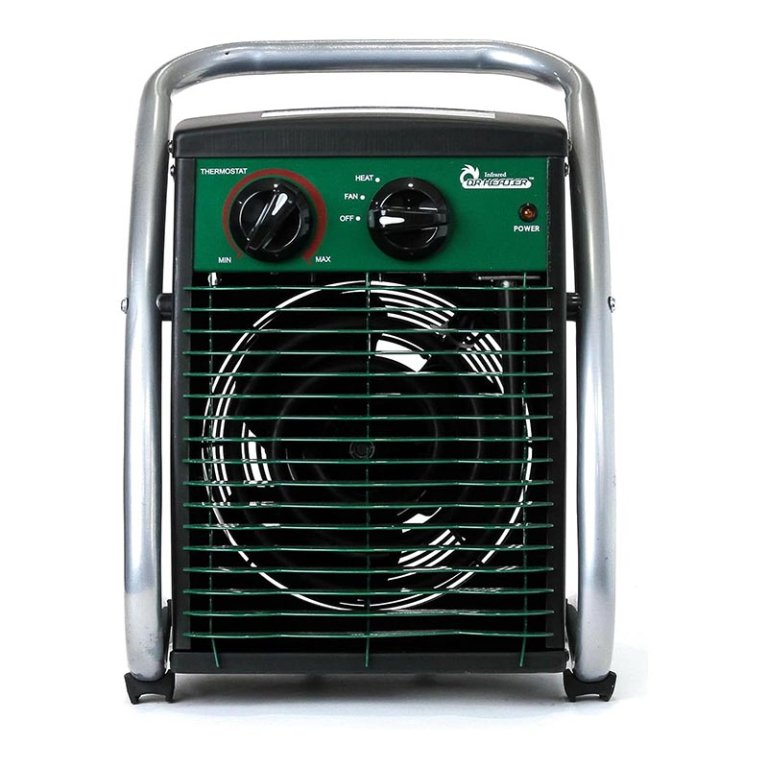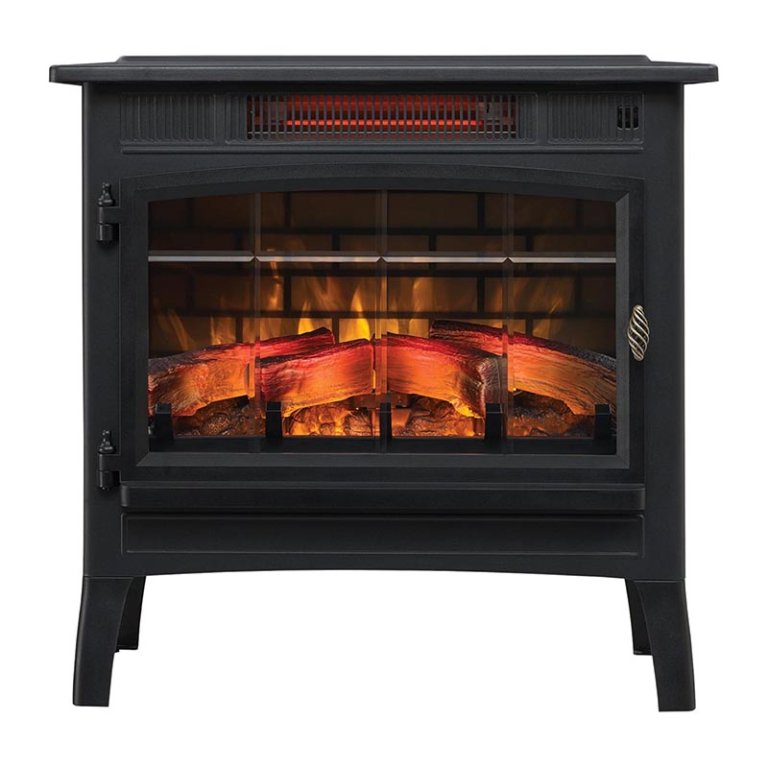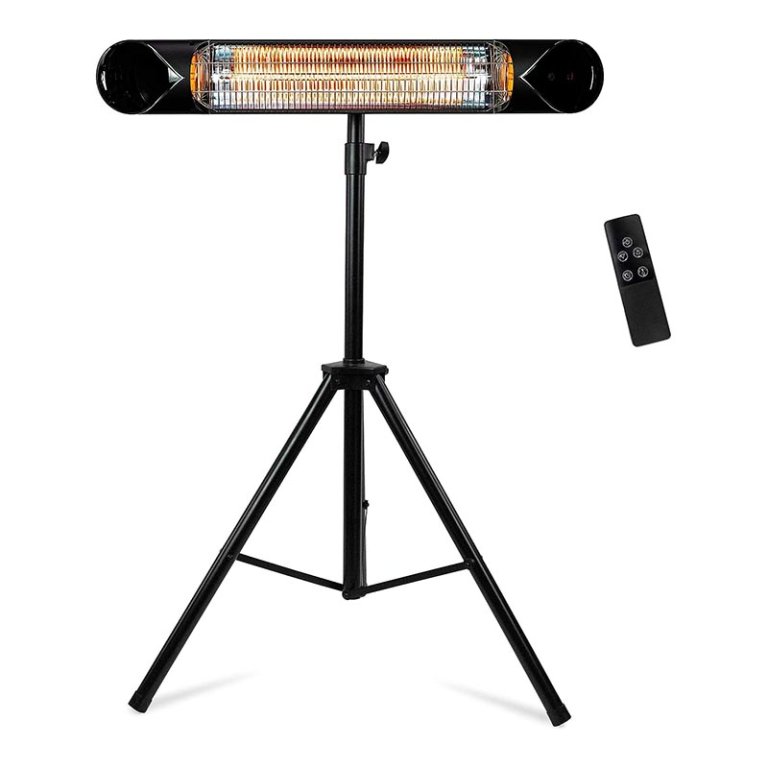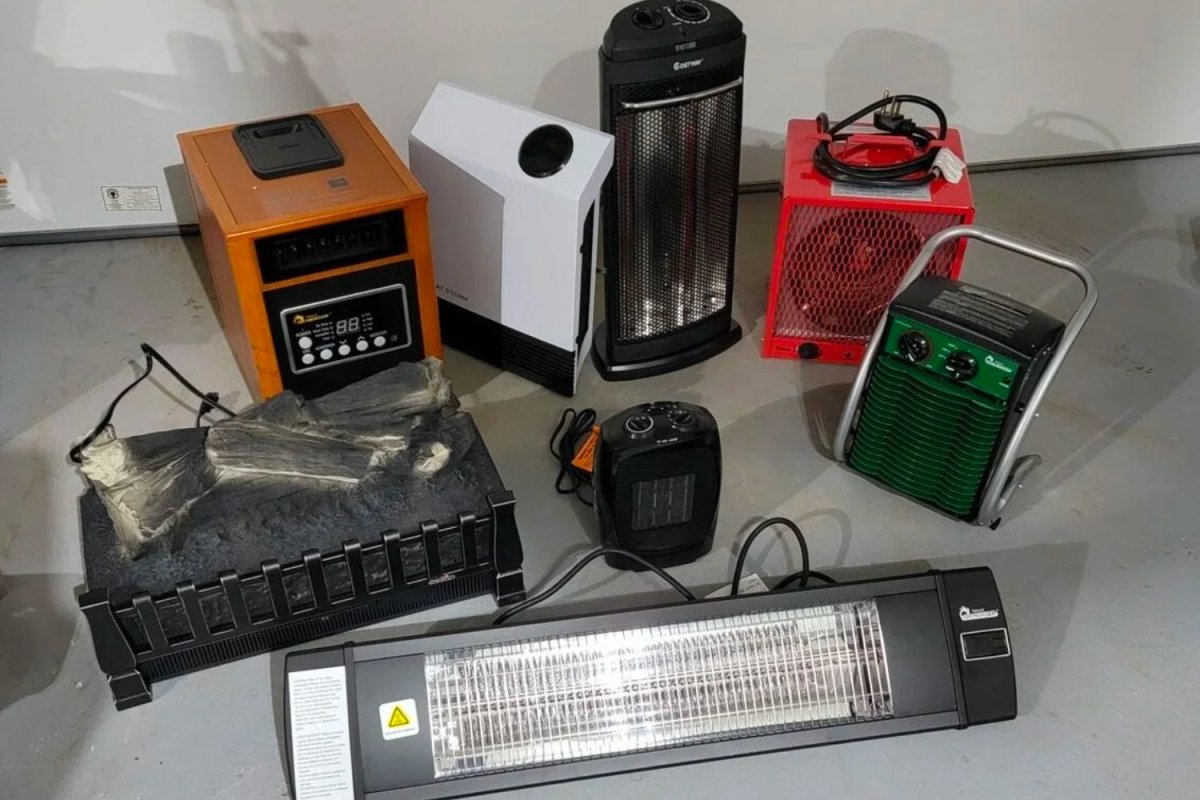
We may earn revenue from the products available on this page and participate in affiliate programs. Learn More ›
While you may be familiar with the convection space heaters used for decades, for more direct heat, infrared heaters are the better portable heating option. We discussed infrared technology with HVAC expert Justin Bohannon of Affordable Solutions HVAC & Electrical in Durham, North Carolina. He has a decade of experience working with heating systems and he agrees that these options are among the most energy-efficient and effective heaters on the market. As he attests, “infrared heaters directly heat objects and people in their path, rather than heating the entire room. This targeted heating approach can lead to energy savings as the heater focuses on heating the occupants instead of wasting energy on unused spaces.” To help shoppers decide on the best infrared heater for their needs, we put a variety of heaters through hands-on testing.
Choosing the best infrared space heater to supplement a primary heating system depends on the space it will heat, as well as budget, portability, safety features, and mounting. We liked the Dr. Infrared Heater DR-968H Portable Space Heater in particular; it’s an effective heater and has a built-in humidifier for additional comfort. Keep reading to find the best infrared heaters for any home.
- BEST OVERALL: Dr. Infrared Heater DR-968H Portable Space Heater
↓ Jump to Review - BEST BANG FOR THE BUCK: Trustech 1,500-Watt Ceramic Desk and Space Heater
↓ Jump to Review - BEST STYLE: Duraflame Infrared Quartz Log Set Heater
↓ Jump to Review - BEST FOR GARAGE: Dr. Infrared Heater DR-988 Portable Industrial Heater
↓ Jump to Review - BEST FOR OUTDOORS: Dr. Infrared Heater DR-238 Outdoor Infrared Heater
↓ Jump to Review - BEST WALL-MOUNT: Heat Storm HS-1500-PHX-WIFI Smart Infrared Heater
↓ Jump to Review - BEST BUILD QUALITY: Dr. Infrared Heater DR-218 Greenhouse Heater
↓ Jump to Review - BEST FLOOR-STANDING: Duraflame 3D Infrared Quartz Fireplace Stove Heater
↓ Jump to Review - BEST FOR AIR QUALITY: EdenPure CopperSmart 1000 Infrared Heater
↓ Jump to Review - BEST FOR PATIOS AND DECKS: Briza Infrared Carbon Heater
↓ Jump to Review
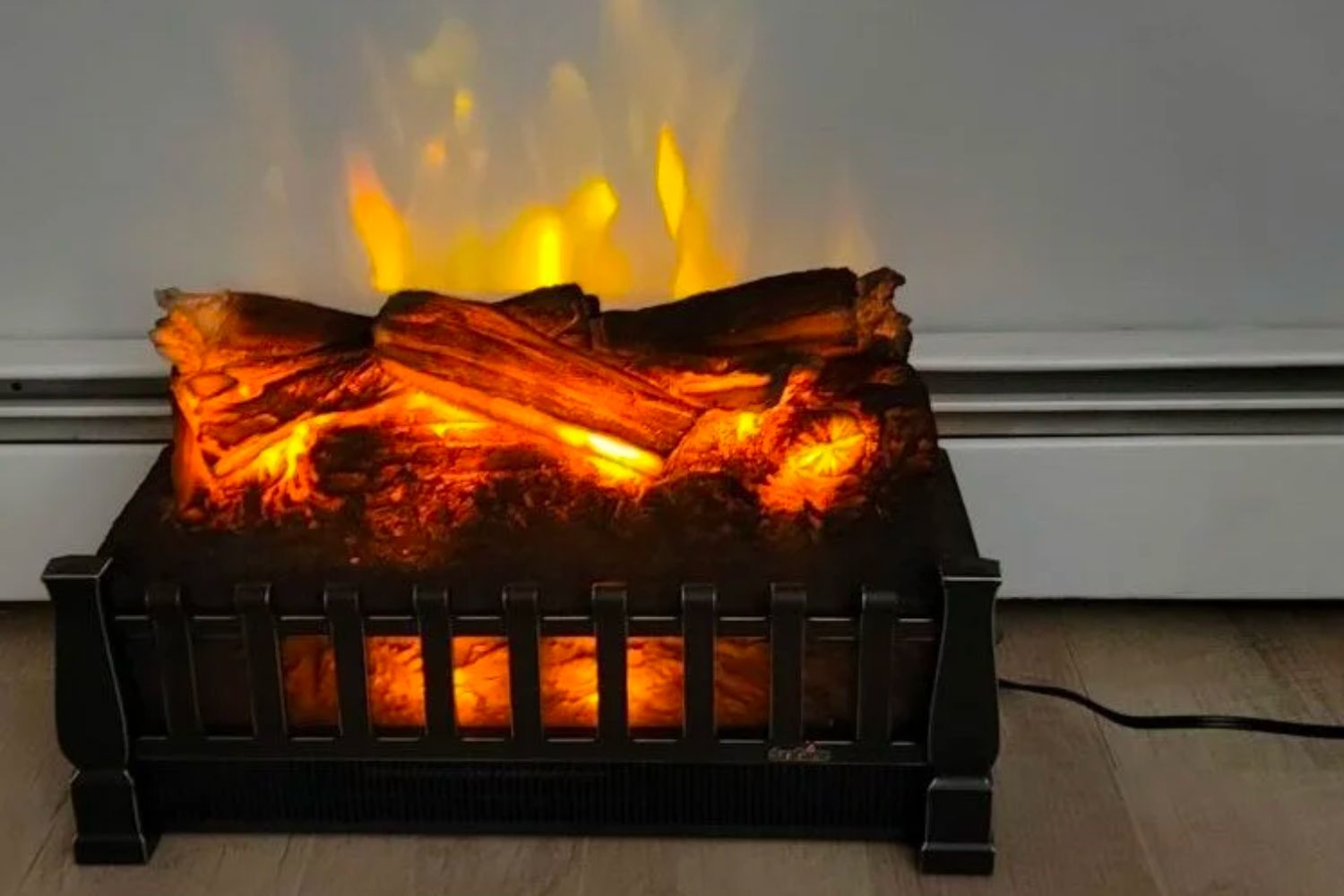
Our Top Picks
We rounded up a bunch of models for hands-on testing and can say, with confidence, that the following are among the best infrared heaters on the market. They range from electric wall heaters to rolling, floor-mounted options, plus plenty in between.
Best Overall
Dr. Infrared Heater DR-968H Portable Space Heater
What We Like
- Built-in humidifier keeps air more comfortable
- Can be adjusted easily with included remote control
- Can spread heat through an entire living space
What We Don’t Like
- Display can be hard to read from standing
Specs
- Wattage: 1,500
- Style: Wheeled
- Portable: Yes
The DR-968H model from Dr. Infrared Heater can warm a room of up to 150 square feet quickly and efficiently with its quartz heating element and powerful blower. A programmable thermostat allows for setting the exact temperature from 50 to 85 degrees Fahrenheit. The low and high setting let users tailor heat output and energy consumption, so they use only as much energy as a particular space requires. Also, the built-in humidifier keeps the warm air comfortable—something most other space heaters cannot do.
The addition of four durable caster wheels supports easy portability from room to room, and it includes a remote control that can operate the heater from across the room. The heater also features a quiet design. Safety features include a tip-over sensor, an automatic shut-off timer, and a cool-touch exterior.
We’re big fans of the Dr. Infrared portable space heater, and we’ve proven it through several tests. First, the built-in humidifier is a stand-out feature. We also really enjoy the remote control and the oscillating louvers that move the warm air around the space. Our only real complaint is that this model sits on the floor, and when looking at the display from a standing height, it can be hard to read.
What our tester says: “I can’t say enough about how nice it is to have a built-in humidifier to keep the air comfortable.”—Tom Scalisi, Product Reviews tester and writer
Get the Dr. Infrared Heater DR-968H at Amazon, Lowe’s, The Home Depot, or Dr. Heater.
Best Bang for the Buck
Trustech 1,500-Watt Ceramic Desk and Space Heater
What We Like
- Incredibly compact design is very portable
- Excellent safety shutoff responsiveness
- Fan-only setting is useful for warmer weather
What We Don’t Like
- Fan speeds can be inconsistent
Specs
- Wattage: 1,500
- Style: Floor or table
- Portable: Yes
When it comes to finding a perfect infrared heater—one that’s portable, powerful, and budget-friendly—Trustech’s infrared heater is a solid option. At just 7.1 inches wide and 9.1 inches tall, this little heater packs 1,500 watts of heating power to keep small spaces toasty. With its integrated carrying handle, it can work in any room with an outlet. This infrared heater produces 750 watts on its “low” setting and 1,500 watts on its “high” setting. It can even serve as a summer fan with a third “wind mode” setting.
Crucial to a movable unit, this portable infrared heaterincludes safety features such as a tip-over shutoff and an automatic overheat protection shutoff. It can only effectively heat a 200-square-foot space, but the portability of this unit is hard to beat. During testing, we found that the only thing holding this little heater back was its power cord—it can go anywhere that has an electrical outlet nearby. We liked the compact design, and when we tipped it over to test its safety switch, it was responsive and shut the heat off immediately (though the fan did continue to run). We’re also “big fans” of that fan, as this infrared space heater can sit on a nightstand or a desk and help manage comfort in both cold and hot weather. Our only complaint is that the fan speed was a bit unreliable—switching between the settings appeared to adjust the fan speed, but only sometimes.
Get the Trustech infrared space heater at Amazon.
Best Style
Duraflame Infrared Quartz Log Set Heater
What We Like
- Produces a high heat output
- Comes with a convenient remote for hands-free adjustments
- Projects realistic-looking flame visuals onto walls
What We Don’t Like
- The fan is loud
- Aesthetic may not be ideal for formal spaces
Specs
- Wattage: 1,500
- Style: Floor
- Portable: Yes
If the ambience of a wood-burning fireplace without the risk and mess is appealing, this Duraflame model from Twin Star Home might fit the bill. It has realistic-looking faux logs and a rolling ember effect that users can adjust with the turn of a knob. Designed as a stationary unit, the heater’s dimensions allow it to sit inside most standard fireplaces, or anywhere else for that matter.
As a stationary unit, it doesn’t include as many safety features as typically seen in a portable model, but it does have a cool-touch exterior. The heater draws 1,500 watts and produces more than 5,200 British thermal units (BTUs), enough to warm most 1,000-square-foot spaces.
Although we thought the Duraflame looked more like a Halloween decoration than a space heater, we still gave it a shot. Puns aside, it warmed our hearts. The projected flame looked realistic, and this unit threw off a good amount of heat too. We also liked the remote control, and while this model shouldn’t ever see the light of day in a formal room, it’s actually pretty fun. Our complaints? There are two: The fan is loud and, of course, the design aesthetic is a little cheesy.
What our tester says: “The flames it projected on the wall looked surprisingly realistic, and the amount of heat it produced was impressive.”—Tom Scalisi, Product Reviews tester and writer
Get the Twin Star Home infrared heater at Amazon or Target.
Best for Garage
Dr. Infrared Heater DR-988 Portable Industrial Heater
What We Like
- Provides consistent warmth throughout entire garage
- Features overheat protection, adjustable thermostat, and large fan
- Carrying handle make it easy to move around
What We Don’t Like
- Requires a specific receptacle
Specs
- Wattage: 5,600
- Style: Floor
- Portable: Yes and no—it needs 240V power
Folks who spend lots of time in the garage all year long benefit from a safe, reliable electric garage heater to stay comfortable. Dr. Infrared Heater’s DR-988 model can pump out between 14,335 and 19,110 BTUs—for perspective, 18,500 BTUs of heat typically can bring a 600-square-foot garage to 95 degrees Fahrenheit. It features an adjustable thermostat for dialing in the ideal temperature and a large fan to spread the heat evenly throughout the space. Although this fan produces more noise than most infrared units, it doesn’t exceed 45 decibels (within the noise range of an average fridge). It also has a carrying handle for easy transport.
Safety features include an automatic overheating shutoff, tip-over protection, and a mesh safety screen in front of the fan. Although a few more safety measures would have been nice, the unit is listed by Underwriter Laboratories (UL) for its safety. Instead of a typical 110-volt (V) power source, it requires a 240V power source that requires a dedicated 30-amp fuse.
We’ve tested this infrared garage heater several times now, and it really does produce quite a bit of heat. It is compact, but the setup is not simple. The problem is that this particular heater’s required volt power and the receptacle that works with it (NEMA #6-30R) were difficult for us to find. But, if you can set up this infrared heater for garage use, it’ll definitely pump out the heat.
Get the Dr. Infrared Heater DR-988 infrared heater at Amazon, Lowe’s, Wayfair, The Home Depot, or Target.
Best for Outdoors
Dr. Infrared Heater DR-238 Outdoor Infrared Heater
What We Like
- Easy to hang with well-designed installation bracket
- Includes a remote for control across a room
- Excellent heat output yet silent operation
What We Don’t Like
- Cord may be too short for some users
- Remote batteries are not included
Specs
- Wattage: 1,500
- Style: Ceiling or wall mount
- Portable: No
To keep the patio partying going into chilly weather, consider Dr. Infrared Heater’s DR-238 model, which is rated for outdoor use. This 1,500W infrared heater has a weatherproof anodized aluminum housing that won’t degrade, and it includes adjustable mounting brackets to hang the heater on an outdoor wall or a ceiling. A carbon heating element and three heat settings allow for adjustable heat output, and it comes with a remote control.
During testing, we found Dr. Infrared Heater’s DR-238 model to be outstanding. First, the bracketry for hanging it on the wall or ceiling made installation incredibly easy. Also, we liked that this model produced a ton of heat without even the slightest hum. The remote was easy to use, and the heater was immediately responsive, but it was the only remote in the test to come without batteries. Also, we’d prefer a slightly longer cord for a ceiling-mounted model (it’s only 6 feet).
Get the Dr. Infrared Heater DR-238 infrared heater at Amazon, Lowe’s, The Home Depot, or Wayfair.
Best Wall-Mount
Heat Storm HS-1500-PHX-WIFI Smart Infrared Heater
What We Like
- Excellent heat output (tested in an uninsulated room)
- WiFi-enabled with smart control from a phone
- Integrates with Google Assistant and Alexa
What We Don’t Like
- The high setting can be a little loud
Specs
- Wattage: 1,500
- Style: Wall mount
- Portable: No
The Heat Storm HS-1500-PHX-WIFI smart infrared heater has a lot to offer folks left in the cold. This compact heater can be installed on a wall with the included brackets. This wall mounted infrared heater has two modes: low at 750 watts and high at 1,500 watts. This allows it to heat rooms up to 750 square feet, when used as a supplemental heating source.
The Heat Storm has some very convenient features. For one, it connects to a home’s Wi-Fi and integrates with Google Assistant or Alexa (but not Apple HomeKit). It also comes with a remote that is simple to use and a large display that makes it easy to read the temperature settings from across the room. A washable air filter is included to clean the air in the space.
This was truly our favorite heater during testing. It’s compact and hangs on the wall without being obtrusive. It was powerful enough to heat one of our uninsulated offices quickly and comfortably in the dead of winter. We could set timers and program settings using our smart devices as well. Our biggest complaint with this model was that the high setting could be a little loud in our experience. It was installed under a desk and needed to be set to low for conference calls.
Get the Heat Storm infrared heater at Amazon, The Home Depot, Tractor Supply, or Menards.
Best Build Quality
Dr. Infrared Heater DR-218 Greenhouse Heater
What We Like
- Rugged and weather-resistant due to all-metal construction
- Compact size with great heat output
- Has overheat protection and an adjustable thermostat
What We Don’t Like
- Slow to produce heat compared to other heaters
Specs
- Wattage: 1,500
- Style: Floor
- Portable: Yes
Space heaters aren’t known for durability, but the Dr. Infrared Heater DR-218 greenhouse heater certainly is. This model features all-metal construction, as it’s built for greenhouses and other tough locations such as workshops, garages, and cabins. It’s also water-resistant, guarding against accidental splashes.
At 1,500 watts, this heater can handle rooms of modest size, garages, and cabins. It has a fan with a sealed ball-bearing motor for sturdiness and longevity, and it requires zero maintenance. It has overheat protection and an adjustable thermostat, plus a fan-only setting.
The one thing we liked most about this model from Dr. Heater was how durable it is. The only problem we had with this heater was that it took a while to warm up, whereas other heaters seemed to heat up much faster.
What our tester says: “It’s sturdy and rugged, but it’s not overly heavy or cumbersome, thanks to its compact design.”—Tom Scalisi, Product Reviews tester and writer
Get the Dr. Infrared Heater DR-218 infrared heater at Amazon, Lowe’s, The Home Depot, or Tractor Supply.
Best Floor-Standing
Duraflame 3D Infrared Quartz Fireplace Stove Heater
What We Like
- Charming rustic design mimics a real wood stove
- Flame effect looks like real flames
- Light enough to carry around, if needed
What We Don’t Like
- Legs are plastic and seem low quality
Specs
- Wattage: 1,500
- Style: Floor
- Portable: Yes, but only because it’s light enough
Folks who want the look of a real wood stove, but would prefer to keep the mess to a minimum, might opt for Duraflame’s 3D infrared quartz fireplace stove heater. This floor-standing model mimics a wood stove and has a light design that looks like real flames inside the unit.
This Duraflame heater features infrared heat with a blower motor; the combination can warm objects and the air in the room. It produces 5,200 BTUs of heat, enough to warm up to 1,000 square feet of space. Temperature adjustments range between 62 and 82 degrees Fahrenheit in 2-degree increments. It comes with a remote, but there is also a control panel hidden behind the door. Although it does not have wheels, this heater is light enough to carry around the house.
We really enjoyed this Duraflame 3D infrared heater during testing. With 1,500 watts, we felt the heat warming objects in the room quickly. We noticed that the flames looked realistic and were relaxing to watch. This helps bolster the charming rustic design even more. We didn’t like that the legs, which had to be attached during setup, were plastic and seemed relatively low quality. But the overall design and output make it suitable for a den, office, or bedroom, though it’s powerful enough to handle much larger rooms. And, should you want to move it, it’s light enough to do so—but we think its good looks will earn it a permanent spot somewhere in the home.
Get the Duraflame infrared heater at Amazon, Target, Wayfair, or Walmart.
Best for Air Quality
EdenPure CopperSmart 1000 Infrared Heater
What We Like
- Washable filter maintains air quality during use
- Wide temperature range is useful
- Easily rolls from room to room
What We Don’t Like
- The design is slightly boring; not as aesthetic
Specs
- Wattage: 1,500
- Style: Floor
- Portable: Yes
One of the biggest drawbacks of forced-air-style heaters and space heaters is the impact they can have on air quality. The EdenPure infrared heater aims to combat that, featuring a lifetime washable filter that can keep the air fresh and clean. This 1,500W heater also offers a copper heating element, which is designed to distribute heat evenly and efficiently. It has a tip-over sensor and a touch-safe front grill cover for safety.
Temperature settings range from 40 to 90 degrees Fahrenheit, making it useful for garages or living rooms, and most spaces in between. Adjustments are easy to make using either the built-in control panel or the remote control. It can heat rooms up to 1,000 square feet. A set of wheels makes it easy to roll from room to room.
The EdenPure packs a lot of punch for a small infrared heater, measuring just 16.75 inches tall by 13 inches wide by 16.5 inches deep. We found it was easy to roll around (it even rolled a bit on its own on our slightly unlevel floors), making it a great choice for those who have multiple rooms to heat. The control panel is clearly visible and the remote works well, so it’s easy to adjust the temperature settings from across the room. The air filter is simple to remove and wash. The design might be a little boring, but the heat output was excellent, and knowing it produces clean air is a nice touch.
Get the EdenPure infrared heater at Amazon.
Best for Patios and Decks
Briza Infrared Carbon Heater
What We Like
- Weatherproof and suitable for outdoor use
- Includes a tripod and wall-mounting brackets
- Quiet; only produces a slight buzz
What We Don’t Like
- Does not have a programmable thermostat
Specs
- Wattage: 1,500
- Style: Floor
- Portable: Yes, but also mountable
Infrared heat is perfect for outdoor patios and decks, and the Briza infrared carbon heater makes a great choice. This large infrared heater features a weatherproof design that can withstand the outdoor rigors of rain, snow, and dust. But, since it’s electric, it can also be used in a screened-in porch or a 3-season room, adding to its versatility.
The model has three settings, including 750 watts; 1,200 watts; and 1,500 watts. It comes with an adjustable tripod for portability but also features brackets to install it on a wall.
What we really liked about the Briza is that it’s true infrared heat, not infrared heat blowing hot, dry air. This warms the objects in the space around it, making it an excellent choice for outdoor heating. It also produces this heat nearly silently (there’s just a low buzz), which means guests won’t have to elevate their voices while staying warm on the patio. We would have preferred a programmable thermostat that turns the heater on and off automatically, but it does feature a timer to make it slightly more programmable.
Get the Briza infrared heater at Amazon, Walmart, or Menards.
Jump to Our Top Picks
How We Tested the Best Infrared Heaters
There are a few things that matter when it comes to testing the best infrared heaters. For one, they must be safe, so they need a sturdy build and/or safety features. Next, they need to produce the right amount of heat.
To test them, we set up each of the heaters according to the manufacturer’s instructions. Some could sit on the floor, while others needed to hang from the wall or the ceiling. We set them up, turned them on, and checked features like remote controls and timers.
First, we examined each radiant heater to see how sturdy or secure it appeared to be. If a heater could tip over, we made sure the safety shutoff worked. We also cranked the heaters as high as they could go to check the surfaces around the mounted heaters for safe temperatures.
Next, we checked the output. We turned each electric infrared heater up to the max setting to see how quickly they’d heat up, and we played with the thermostats to ensure they were working properly. From there, we compared the design and build quality between each model.
What to Consider When Choosing an Infrared Heater
Infrared rays are uniquely capable of cutting through empty space and bringing warmth to the objects they strike; in fact, that’s how the sun heats the earth. Today’s infrared heaters bring warmth to objects, like clothes and skin rather than the surrounding air—an efficient mechanism in stark contrast to convection heaters, which warm the surrounding air before heating objects in that space.
Although heating the air may distribute heat more uniformly throughout a room, much energy is wasted heating unoccupied space, such as high ceilings or the outdoor air. Infrared heaters use 100 percent of the heat they produce to bring focused warmth to the objects in the path of its rays, making them much more energy efficient. An infrared heater’s energy efficiency, space coverage, and other features will vary depending on certain factors. Shoppers may want to keep the following considerations in mind while on the hunt for the best infrared heater for their homes.
Size
When determining the right size of an infrared heater to buy, think about the square footage of the space you want to warm. Generally, infrared heaters are relatively small and portable. More powerful units for bigger areas are available, but they’re typically larger. Also, consider how much floor space an infrared heater will take up; this will vary depending on whether the unit sits vertically (in the case of a tower heater) or horizontally (like most standard heaters).
Power
The size of the space you want to warm will also influence how powerful your heater should be. The amount of heat generated by these devices, measured in BTUs, influences the size of the space they can heat.
The BTU output of an infrared heater generally correlates with the number of watts the heater uses, which can range between 300 and 1,500 watts. (Most are capped at 1,500 watts because that’s the maximum amount a standard 110V household electrical outlet can handle.) With convection space heaters, 1 watt is equivalent to 3.412 BTUs, so it’s simple to determine the size of a space they can warm; it’s not so easy with infrared heaters.
Infrared heaters can use various heating elements, such as quartz (the most common and most efficient), ceramic, and carbon, to produce and emit infrared rays with varying levels of energy efficiency. Supplemental fans or blowers aren’t necessary, but they can provide both focused infrared heat and diffused heat through convection.
These factors impact how an infrared heater’s power rating will affect its heat output and space coverage. Just because an infrared heater boasts a higher power rating doesn’t mean it produces more heat and provides greater space coverage—much depends on the individual characteristics of the heater.
One way to calculate the general amount of power a heater should generate is to multiply the space’s square footage by 10. For example, a 100-square-foot room (10 feet by 10 feet) will need a 1,000-watt heater (100 x 10 = 1,000).
Intended Location
The location of an infrared heater warrants consideration due to its unique heating action. Whether it’s for outdoor use or a space heater for a basement, generally, it’s a good idea to place an infrared heater directly in front of what you want to warm. But, to be on the safe side, we consulted HVAC expert Bohannon to see where infrared heaters should be placed, and he recommends that “infrared heaters should not be placed near flammable materials such as curtains, furniture, or paper,” he says. He adds to always maintain adequate clearance around the heater to avoid any fire hazards. “It’s also important to follow the manufacturer’s guidelines regarding safe distances from walls and other objects,” Bohannon says.
The fact that they operate by emitting heat waves directly to objects (as opposed to the surrounding air) also makes them well suited to outdoor spaces, such as patios, since the heat won’t dissipate in the surrounding air. Similarly, infrared heaters are a good option for rooms with large ceilings since users needn’t worry about heated air rising and wasting away in the ceiling space.
Design
An infrared heater needn’t be an eyesore, as there are various designs to complement different styles of home decor. Shoppers can find heaters with wood, plastic, and metal finishes, all in various colors.
The shape of the heater will depend on whether it sits on the floor vertically or horizontally, which affects not only its function but its visual form as well. Some infrared heaters simulate the appearance of a fireplace with visual and auditory effects like flames and crackling.
Portability
Infrared heaters can range from highly portable to completely stationary units. The majority are for supplemental space heating, so they’re usually portable. Some models are portable by design; they’re tidily compact and include carry handles and caster wheels. Handles and wheels are helpful for larger, heavier units that would otherwise be difficult to move. Other models, like those that hang from the wall and ceiling, aren’t portable at all.
Safety Features
Space heaters are a leading cause of house fires, so choosing an infrared heater with safety features is important. This is especially true for homes with pets or children who could knock the unit over. Fortunately, many manufacturers do incorporate several safety features, including:
- Automatic tip-over shutoff
- Automatic overheat shutoff
- Automatic shut-off timers that turn the heater off after a certain length of time
- Cool-touch external casings
Look for a heater with at least two of these safety features, but the more, the better. For added confidence, find a heater that’s certified by a third-party inspection agency, such as Underwriter Laboratory (with a UL logo), Intertek (stamped with the letters ETL and corresponding logo/emblem), or Canadian Standards Association (stamped with a CSA logo/emblem).
Additional Features
Some infrared heaters boast bells and whistles to increase functionality. These may include:
- Variable heat settings: Although infrared heaters are energy efficient, users can maximize that efficiency with variable heat settings on an infrared heater with thermostat. This feature also lets you customize the heat output to make a space as comfortable as possible. This is especially valuable in a portable heater since it allows you to place it in different rooms with different settings, all with the same comfort level.
- Oscillation: To truly maximize the heating efficiency, consider a unit with an oscillating base to uniformly heat a space. Instead of the heater warming the space in its immediate path, it oscillates from side to side to heat at a 180-degree angle.
The Advantages of Owning an Infrared Heater
Energy-efficient infrared heaters are capable of heating the objects in a space more quickly than other types of heaters, such as convection-style units that must warm the surrounding air before they can heat the objects. They’re also usually quieter than other heaters since they don’t require fans—and those units that do have fans aren’t usually very loud. The warmth infrared heaters create won’t increase humidity or dry the air in the room, so the heat is more comfortable. Other benefits include:
- Energy efficiency means a lower carbon footprint, making infrared heaters more environmentally friendly than less-efficient units.
- Infrared heaters require less maintenance than forced-air heaters, which have more moving parts.
- Infrared heaters burn cleaner than some other heater types (particularly gas-operated varieties), so they can help preserve your indoor air quality.
FAQs
If you still have questions about infrared heaters, see the answers to some common questions below for greater clarity.
No. In fact, they can use considerably less than other heaters because of how efficiently they heat up a space.
While infrared heaters are intrinsically safer than most other types of heaters, they should only be left on overnight if they have integrated safety features like an automatic tip-over shutoff, an overheat shutoff, and a shut-off timer.
Infrared heaters should only be used in the locations they are designed for. Consequently, only infrared wall heaters should be mounted on a wall.
Infrared heaters provide direct heat, so you’ll want to place it facing the area where you want to concentrate the warmth. Make sure there aren’t obstructions in the way.
Expect home infrared heaters to last about the same amount of time as other space heaters; a few years, with some good products (that are also well taken care of) lasting over a decade.
Yes, it’s possible to heat an entire house with infrared heating. However, it is usually done with larger infrared heating panels, not the more compact units like those on this list. The smaller heaters in this guide are best for supplementary heating, as a toasty addition to your home heating system.
Why Trust Bob Vila
Bob Vila has been America’s Handyman since 1979. As the host of beloved and groundbreaking TV series including “This Old House” and “Bob Vila’s Home Again,” he popularized and became synonymous with “do-it-yourself” home improvement.
Over the course of his decades-long career, Bob Vila has helped millions of people build, renovate, repair, and live better each day—a tradition that continues today with expert yet accessible home advice. The Bob Vila team distills need-to-know information into project tutorials, maintenance guides, tool 101s, and more. These home and garden experts then thoroughly research, vet, and recommend products that support homeowners, renters, DIYers, and professionals in their to-do lists.
Meet the Tester
Tom Scalisi is a full-time DIY and construction writer for many of the largest websites in the industry, including BobVila.com, This Old House, Family Handyman, and Forbes. He also owns and operates a pest control blog, RiddaBugs.com. He spent years working in the trades and industrial building maintenance, repairing heating and cooling equipment.
Additional research provided by James Fitzgerald.
